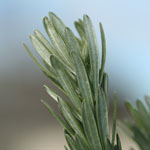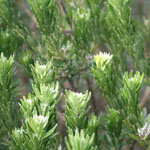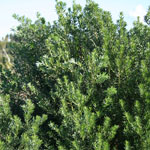Flax-leaved broom
Common name:
- Flax-leaved broom
Scientific name:
- Genista linifolia L.
Plant status
Catchment management authority boundaries
Regionally prohibited in the North East and East Gippsland catchments.
Regionally controlled in the Wimmera, Corangamite, West Gippsland, Port Phillip and Western Port catchments.
Restricted in the Mallee, North Central, Glenelg Hopkins and Goulburn Broken catchments.
Plant biology
Appearance
Shrub (or bush)
Description
Flax-leaved broom is an erect, evergreen shrub which can grow up to 3m high.
Stems
Stems are erect, brownish-green and are ridged. Young branches are densely hairy.
The stems consist of 1 main stem at the base and many branches above.
Leaves
Flax-leaved broom leaves are light green and arranged alternately on branches without stalks. They are hairy on the upper surface and densely hairy beneath, giving a whitish appearance.
They consist of three linear lance-shaped leaflets each about 2 to 3cm long that are slender with rolled edges.
Flowers
Flax-leaved broom flowers are bright yellow and pea-like. They grow to 1.2cm long, have short stalks and occur in clusters at the ends of branchlets.
Fruit
A grey to black silky pod, about 2.5cm long, containing 2 or 3 greenish-brown seeds.
Growth and lifecycle

Method of reproduction and dispersal
Flax-leaved broom is spread by seeds that are ejected from its pods at a distance of up to 5m in summer. More distant spread occurs when seeds contaminate vehicles, machinery, produce, mud and soil.
Seedlings form dense clumps and grow readily on disturbed areas such as graded roadsides.
Rate of growth and spread
Flax-leaved broom takes about two years to reach sexual maturity.
Seedbank propagule persistence
A bush of flax-leaved broom contains approximately 2000 flowers which may produce over 4000 seeds per year.
The seeds have a hard seed coat that requires heat or some form of superficial cutting, abrasion or incision to break dormancy and stimulate germination. Seeds remain viable in the soil for many years.
Flax-leaved broom can form dense thickets and the plant can produce seeds for 3 to 10 years.
Preferred habitat
Flax-leaved broom prefers warm-temperate regions with slightly acidic soils in areas with moderate rainfall.
Distribution
In Victoria, flax-leaved broom is common on the Mornington Peninsula and adjoining areas, as well as on the Bellarine Peninsula and parts of the Western District of the state. It is also well established in the La Trobe Valley area around Morwell and Traralgon.
Growth calendar
The icons on the following table represent the times of year for flowering, seeding, germination, the dormancy period of Flax-leaved broom and also the optimum time for treatment.
| Jan | Feb | Mar | Apr | May | Jun | Jul | Aug | Sep | Oct | Nov | Dec | |
|---|---|---|---|---|---|---|---|---|---|---|---|---|
| Flowering | ||||||||||||
| Seeding | ||||||||||||
| Germination | ||||||||||||
| Dormancy | ||||||||||||
| Treatment |
Impact
Impact on ecosystems and waterways
Flax-leaved broom has the ability to invade a broad range of vegetation including:
- grasslands
- woodlands
- heathlands
- forests
- riparian areas.
It is found predominantly on roadsides, drains and fence lines from which it encroaches onto grazing lands.
It has the ability to crowd out smaller shrubs and ground-flora species, mainly lower and mid-storey plants, and eventually impact the food sources of native fauna.
Agricultural and economic impacts
Flax-leaved broom's impact on agricultural industries is limited as it mostly occurs in poorer pastures. However, it can form dense thickets which would exclude most other vegetation, resulting in an impact on yield.
The plant provides a haven for pest animals and has the ability to reduce grazing.
Flax-leaved broom takes about 2 years to reach sexual maturity. In cropping situations the weed will not develop sufficiently to produce seed that may contaminate seed crops.
Social value and health impacts
It was initially used as a hedge plant and can develop into dense infestations which can pose a significant barrier to people. The weed is highly invasive and can be found in a variety of natural habitats including forest margins and riparian areas, resulting in a restriction of some recreational activities.
The seeds of this weed are highly poisonous.
Management
Prescribed measures for the control of noxious weeds:
- application of a registered herbicide
- physical removal.
Read about prescribed measures for the control of noxious weeds.
Other management techniques
Changes in land use practices and spread prevention may also support flax-leaved broom management after implementing the prescribed measures.